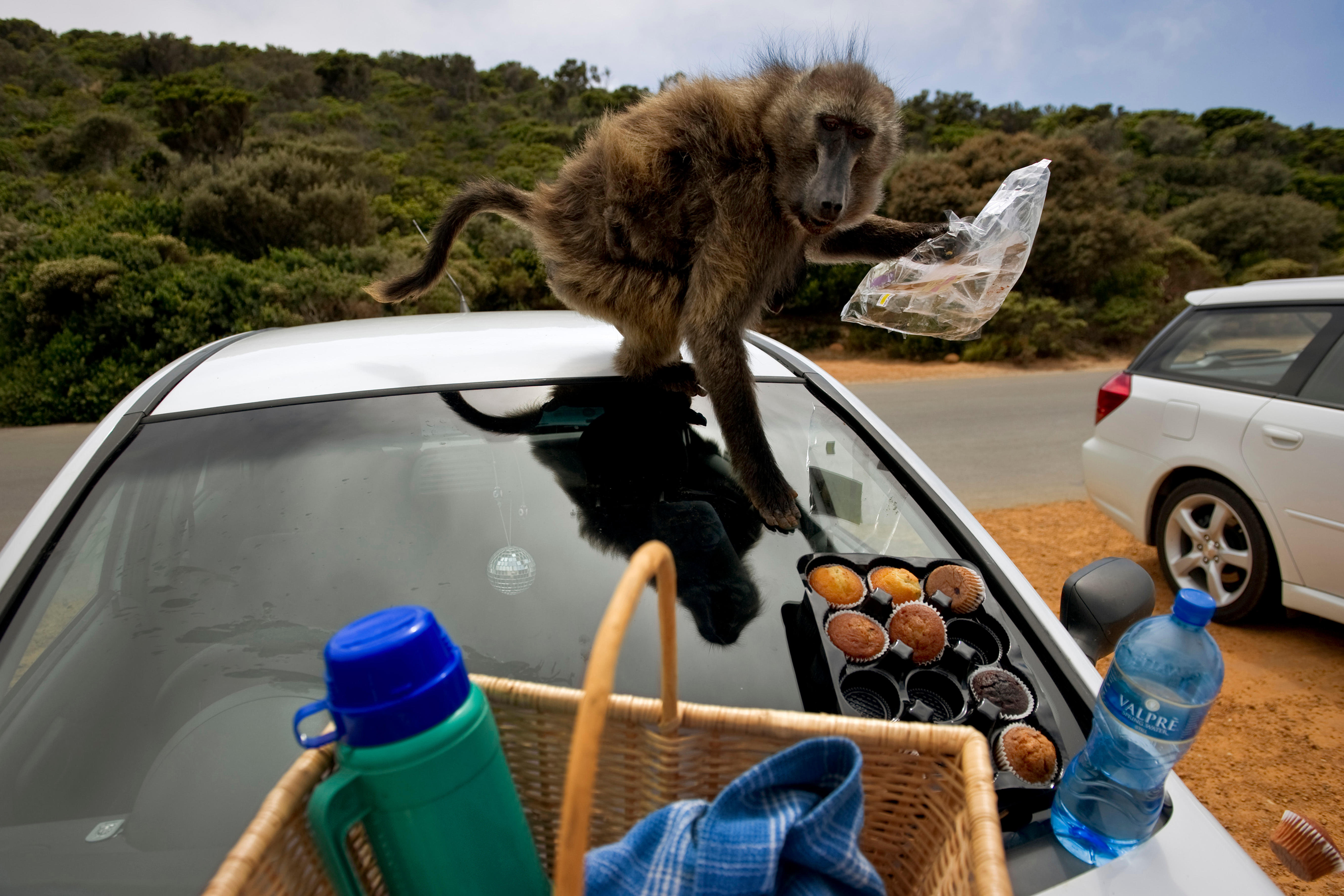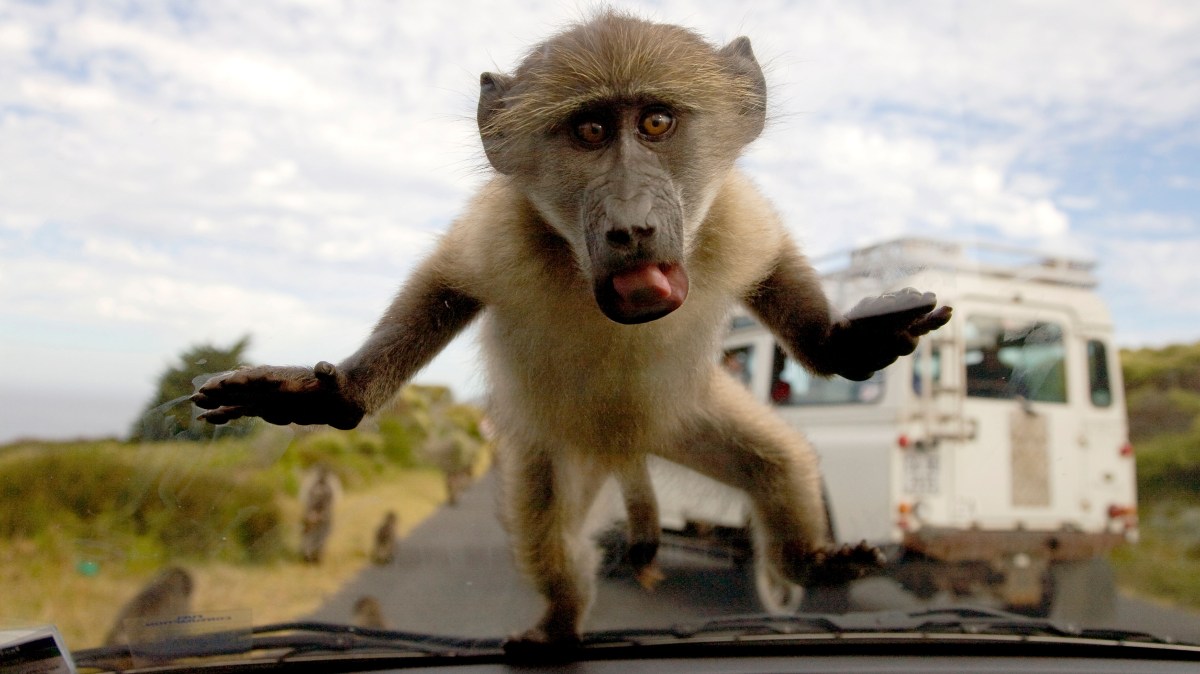Three armed guards fan out on a busy road, blocking the route from the forested lower slopes of Table Mountain to one of Cape Town’s most exclusive suburbs.
A baboon troop peers from the shadows, poised to dash between cars and vault over walls to where kitchens and compost heaps offer far richer pickings than nuts and insects on the forest floor.
Better still, during harvest, are the vineyards of Constantia that now cover much of the baboons’ traditional foraging range. If they make it past the electric fences and stick-wielding workers, the troop can gorge on grapes before being chased back through gardens and traffic and — if they survive — coming home to roost in Cecilia Forest.
Chacma baboons are a protected species on the Cape Peninsula and the city pays monitors to help maintain peace between the animals and the human population expanding around them.
From dawn until dusk, Mzukisi Nkewu, a monitor for 18 years, shadows the 16-strong troop known as CT2 and knows every face. He points out some new arrivals clinging to their mothers’ backs. His air-pressured rifle is a last resort to keep them in the forest.
“This is usually enough,” Nkewu says, rattling a box of paintball ammunition that sends a young male approaching the road scurrying back. “If they get into the houses, things can quickly get dangerous with dogs, bangers, even live rounds.”
Over the past year, four adult males have vanished from CT2, presumed killed, with their bodies never found. Similar tensions are playing out across the peninsula, where kitchen invasions are common and residents complain it is no longer safe to entertain in their gardens.

Easy pickings from a picnic left on a car
The city has appointed a task force to consider measures that include moving the worst-offending troops to a sanctuary — or even euthanasia.
The CT2 baboons forage today on what was once part of the estate of Cecil John Rhodes, the Victorian-era British imperialist and prime minister of the Cape Colony whose ambition was a “Cape to Cairo” empire.
Highly intelligent and deeply social, chacma baboons have roamed this region for thousands of years. Their presence is etched into rock art across southern Africa and entwined in human history. Hunter-gatherers regarded them as good neighbours who raised the alarm on approaching predators and were guides to water sources and plants that could be eaten or used to ease the illnesses baboons share with man.
“The presence of baboons runs through the human record here,” says Sandra Swart, a history professor at Stellenbosch University with a particular focus on changing human-animal relationships.
The advent of farming strained relations when baboons became viewed as crop-raiding vermin. Ever since, they have been treated as a nuisance to hunt, or at best “manage” — tricky tasks given how expert baboons have become about their human neighbours.

Dustbins in the Cape have special latches to fend off foraging baboons
RODGER BOSCH/AFP/GETTY IMAGES
Their close resemblance to humans made them useful subjects for medical breakthroughs and darker purposes. The world’s first successful human heart transplant, performed in Cape Town at Groote Schuur hospital in 1967, was made possible by perfecting the technique on baboons.
Later the apartheid regime’s chemical and biological warfare programme, codenamed Project Coast, used the animals in tests designed to target black communities. Its head, Wouter Basson, is still a practising cardiologist in Cape Town.
Surviving in ever-shrinking pockets of their former range, penned by highways and housing, baboons now bear the brunt of a society increasingly obsessed with security.
As residents fortify themselves against worsening crime, they project their fears onto the most human-like wildlife, meting out vigilante punishment to baboons picking through bins as though they were armed intruders.
“Baboons are judged and punished by a moral code they can’t possibly understand,” Swart says.
• Fitbits prove even baboons find toddlers tough going
The prospect that up to 120 animals in five troops including CT2 — out of a peninsula population of 490 — may be put down has outraged animal rights groups, who blame rising tensions on poor management of land and food waste.
Swart believes that trying to eliminate baboons as man’s close neighbours is short-sighted. Humanity has long learnt from the species, she says, and baboons may still hold lessons on how to survive in a changing climate. “If we lose contact with them, we risk losing not just a keystone species in our local ecology, but a way of seeing the world in a way we urgently need.”
As dusk falls over Cecilia Forest, Nkewu and his colleague watch the CT2 troop climb into the trees for the night. The monitors have held the line all day, keeping the baboons from spilling into the homes where security lights are now flickering on.
